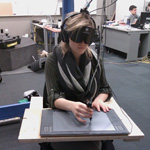
Can spatial auditory cues enable us to remain oriented while navigating real or virtual environments?
Non-visual navigation interfaces are crucial for the blind, who suffer great reductions in mobility because of the difficulty of navigating new environments. Sighted users may also benefit from these types of displays when they are navigating but can’t see the screen of their mobile device because they are using their hands for something else (e.g. cycling). We are investigating the psychological factors that underly auditory displays, and building off of previous work to design new auditory displays for navigation.
Publications
Sorry, there’s no items to display.